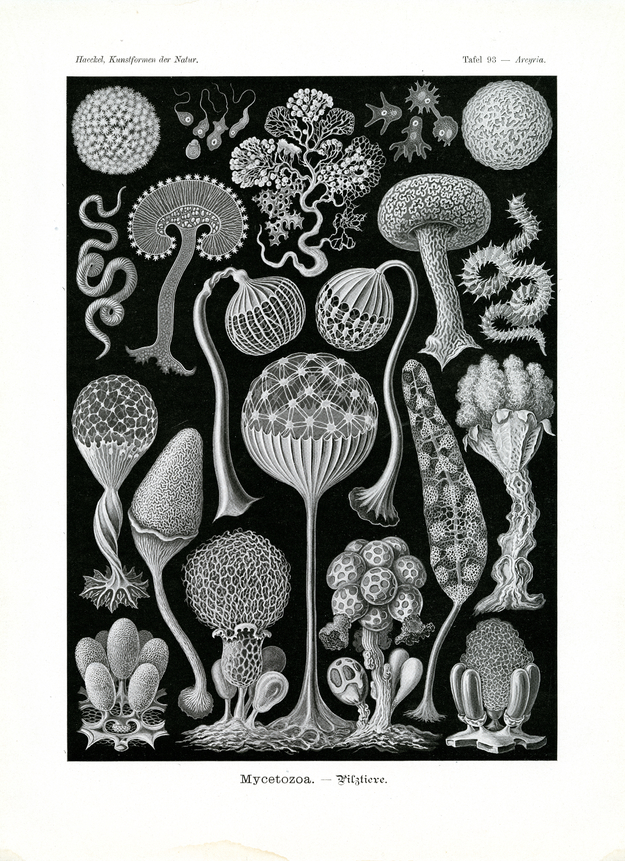Translation of the original German introduction by Ernst Haeckel:
Phylum of Protozoa (Urtiere); - main class of Rhizopoda (Wurzelfüßer); - class of Mycetozoa (Pilztiere).
The peculiar protists that modern zoologists call ‘fungus-animal’ (Mycetozoa) were considered to be plants fifty years ago and accommodated as a special order within the class of fungi (Mycetes, plate 63 and 73). Only in the year 1858 with the history of germ development fully clarified it was understood that they have nothing in common with real fungi, rather belong to the main class of Rhizopoda among the protists; here they form a distinct class (with more than 300 species).
All Mycetozoa are terrestrial organisms, preferably to be found on decaying plant parts (rotten wood, old tree bark, decomposing leaves); as ‘plasmophageous animals’ they feed on decomposing substances (Saprosites). During their life-cycle they undergo two most distinct states; during the first, flexible status (Kinesis) they form naked plasma bodies movable like other Rhizopoda, feeding like them and growing considerably (fig. 1-3). During the second, resting status (Paulosis) the shape-changing plasma bodies (Plasmodia) have consolidated into a simple, usually nodular or ovoid mass known as ‘spore-vesicle’ (Sporangium, fig. 4-20); it is filled with thousands of most minute germ cells or spores. During germination of ‘fungus-animals’ (in water) out of the firm cover of each spore emerges a small, naked germ cell (fig. 1, below); it soon protrudes a very thin, threat-like appendage of plasma swimming in the water with the help of this flagellum. These ‘swarming spores’ (fig. 1), however, soon retract their flagella and transform into creeping Myxamoebae, i.e. into naked, mononuclear cells similar to common amoeba and slowly changing their shape (fig. 2). With many such Myxamoebae coalescing bigger, several centimeter long plasma bodies, Plasmodia (fig. 3) develop. As soon as the growing plasmodium reaches a certain size it contracts into a compact, rounded mass, deposits its outer, firm protective cover (Peridium) and disintegrates within it into thousands of small, rounded spores, each with a nucleus. The remnants of the plasma in between the spores form a web of very delicate filaments (Capillitium, fig. 8 and 9). As soon as the ripe (often petiolate) amniotic sac bursts open the elastic Capillitium advances on top of the open Peridium and disseminates spores (fig. 10-20).
Translation by VR Translators Bangalore
We've scanned the original lithography at 1200dpi on the Epson A3 scanner of A3 scanner huren. You can download a 400dpi JPEG here
